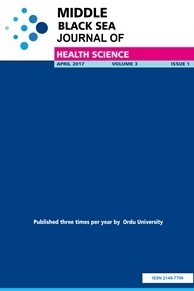Antibacterial Activity of a Series Engineering Nanoparticles Against Oral Anaerobic Periodontal Pathogens Species in Vitro
Antibacterial activity, Aggregatibacter actinomycetemcomitans, engineering nanoparticles, Porphyromonas gingivalis
Antibacterial Activity of a Series Engineering Nanoparticles Against Oral Anaerobic Periodontal Pathogens Species in Vitro
antibacterial activity, engineering nanoparticles, aggregatibacter actinomycetemcomitans, porphyromonas gingivalis,
___
- 1. Adibkia K, Omidi Y, Siahi MR, Javadzadeh AR, Barzegar-Jalali M, Barar J, et al. Inhibition of endotoxin-induced uveitis by methylprednisolone acetate nanosuspension in rabbits. J Ocul Pharmacol Ther. 2007;23(5):421-432.
- 2. Dizaj SM, Lotfipour F, Barzegar-Jalali M, Zarrintan MH, Adibkia K. Antimicrobial activity of the metals and metal oxide nanoparticles. Mater Sci Eng C. 2014;44:278-284.
- 3. Stoimenov PK, Klinger RL, Marchin GL, Klabunde KJ. Metal oxide nanoparticles as bactericidal agents. Langmuir. 2002;18(17):6679-6686.
- 4. Allaker RP. The use of nanoparticles to control oral biofilm formation. J Dent Res. 2010;89(11):1175-1186.
- 5. Leistevuo J, Järvinen H, Österblad M, Leistevuo T, Huovinen P, Tenovuo J. Resistance to mercury and antimicrobial agents in Streptococcus mutans ısolates from human subjects in relation to exposure to dental amalgam fillings. Antimicrob Agents Chemother. 2000;44(2):456-457.
- 6. Sweeney LC, Dave J, Chambers PA, Heritage J. Antibiotic resistance in general dental practice a cause for concern? J Antimicrob Chemother. 2004;53(4):567-576.
- 7. Feng QL, Wu J, Chen GQ, Cui FZ, Kim TN, Kim JO. A mechanistic study of the antibacterial effect of silver ions on Escherichia coli and Staphylococcus aureus. J Biomed Mater Res. 2000;52:662-668.
- 8. Yamanaka M, Hara K, Kudo J. Bactericidal actions of a silver ion solution on Escherichia coli, studied by energy-filtering transmission electron microscopy and proteomic analysis. Appl Environ Microbiol. 2005;71:7589-7593.
- 9. Khan ST, Al-Khedhairy AA, Musarrat J. ZnO and TiO2 nanoparticles as novel antimicrobial agents for oral hygiene: a review. J Nanopart Res. 2015;17(6):276.
- 10. Yavuz MC, Canakci CF. Evaluation of Serum, Saliva and GCF Visfatin Levels in Chronic Periodontitis Patients with Uncontrolled/ Controlled Type2 Diabetes Mellitus. Selcuk Dental Journal. 2021;8(3):817-823.
- 11. Sari A, Davutoglu V, Bozkurt E, Tarakcioglu M, Erciyas K. Effect of periodontitis on oxidative stress parameters in patients with rheumatic heart valve disease. Arch Oral Biol. 2021;121:104961.
- 12. Van Dyke TE. Pro-resolving mediators in the regulation of periodontal disease. MolAspects Med. 2017;58:21-36.
- 13. Han YW, Wang X. Mobile microbiome: oral bacteria in extra-oral infections and inflammation. J Dent Res. 2013; 92(6):485-491.
- 14. Dizaj SM, Lotfipour F, Barzegar-Jalali M, Zarrintan MH, Adibkia K. Antimicrobial activity of the metals and metal oxide nanoparticles. Mater Sci Eng C. 2014;44:278-284.
- 15. Seil JT, Webster TJ. Antimicrobial applications of nanotechnology: methods and literature. Int J Nanomedicine. 2012;7:2767–2781.
- 16. Adibkia K, Alaei-Beirami M, Barzegar-Jalali M, Mohammadi G, Ardestani MS. Evaluation and optimization of factors affecting novel diclofenac sodium-eudragit RS100 nanoparticles. Afr J Pharm Pharmacol. 2012;6:941–947.
- 17. Adibkia K, Barzegar-Jalali M, Nokhodchi A, Shadbad MS, Omidi Y, Javadzadeh Y, et al. A review on the methods of preparation of pharmaceutical nanoparticles. J Pharm Sci. 2010;15:303–314.
- 18. Ravishankar V, Rai A, Bai J. Nanoparticles and their potential application as antimicrobials, Science Against Microbial Pathogens: Communicating Current Research and Technological Advances. 2011;197–209.
- 19. Daglioglu Y, Yilmaz O. The assessment of biological accumulation on exposure in boron particles of desmodesmus multivariabilis. Biological Diversity and Conservation. 2016;9:204-209.
- 20. Yılmaz O, Daglioglu Y. The Ecotoxicological effects of ZnO-TiO2 nanocomposite in chodatodesmus mucranulatus. Fresenius Environmental Bulletin. 2018; 27: 2951-2962.
- 21. Monzavi A, Eshraghi S, Hashemian R, Momen-Heravi F. In vitro and ex vivo antimicrobial efficacy of nano-MgO in the elimination of endodontic pathogens. Clin Oral Investig. 2015:19(2);349-356.
- 22. Besinis A, De Peralta T, Handy RD. The antibacterial effects of silver, titanium dioxide and silica dioxide nanoparticles compared to the dental disinfectant chlorhexidine on Streptococcus mutans using a suite of bioassays. Nanotoxicology. 2014;8(1):1-16.
- 23. Sondi I, Salopek-Sondi B. Silver nanoparticles as antimicrobial agent: a case study on Ecoli as a model for Gram-negative bacteria. J Colloid Interface Sci. 2004;275(1): 177-182.
- 24. Brayner R, Djéga-Mariadassou G, da Cruz GM, Rodrigues JAJ. Hydrazine decomposition over niobium oxynitride with macropores generation. Catalysis today. 2000;57:225-229.
- 25. Liu YJ, He LL, Mustapha A, Li H, Hu ZQ, Lin MS. Antibacterial activities of zinc oxide nanoparticles against Escherichia coli O157: H7. Journal of applied microbiology. 2009;107.4:1193-1201.
- 26. Sharma Virender K, Yngard Ria A, Yekaterina L. Silver nanoparticles: green synthesis and their antimicrobial activities. Advances in colloid and interface science. 2009;145.1-:83-96.
- 27. Choi O, Deng KK, Kim NJ, Ross J, L Surampalli RY, Hu Z. The inhibitory effects of silver nanoparticles, silver ions, and silver chloride colloids on microbial growth. Water research. 2008;42: 3066-3074.
- 28. Vargas-Reus MA, Memarzadeh K, Huang J, Ren GG, Allaker RP. Antimicrobial activity of nanoparticulate metal oxides against peri-implantitis pathogens. Int J Antimicrob. 2012;40(2):135-139.
- 29. Malarkodi C, Rajeshkumar S, Paulkumar K, Vanaja M, Gnanajobitha G, Annadurai G. Biosynthesis and antimicrobial activity of semiconductor nanoparticles against oral pathogens. Bioinorganic chemistry and applications. 2014.
- 30. Jin T, He Y. Antibacterial activities of magnesium oxide (MgO) nanoparticles against foodborne pathogens. J Nanopart Res. 2011;13(12):6877-6885
- Yayın Aralığı: Yılda 4 Sayı
- Başlangıç: 2015
- Yayıncı: Ordu Üniversitesi
Umbilical Cord Seperation Time and Related Factors
Nazan GÜRARSLAN BAŞ, Nilgün SÖYLEMEZ, Gülnaz KARATAY
Shylaja J, Huda MOHAMMED TALEA ASİRİ, Nouf MOHAMMED AHMAED AL MAKTHER, Alaa AHMAD ALSAYED, Hind ALI AYED ALHBIRY ASIRI, Fathima ALİ MOHAMMED AQİLİ, Amal HABIB MOHAMMED ALAMMARI
Seda KESKİN, Deha Denizhan KESKİN
Analysis of Forensic Geriatric Patients Admitted to Emergency Department
Meltem KÖKDENER, Latif DURAN, İskender AKSOY, Mehmet EKİZ
YouTube as an educational resource in neurosurgery
Ufuk KAYA, Elif GÜNEŞ, Elif EREN, Mohammed ISSA, Emrah GÜLER, Aslı AYKAÇ, Nedim CAKİR, Kaya SÜER
An Analysis of Youtube Videos on the Topics of Coronavirus and Dentistry
Ayça KURT, Tuğba SERİN KALAY, Elif KİBAROĞLU
Surgical Nurses’ Pain Related Knowledge, Attitude and Clinical Decision Making Skills
